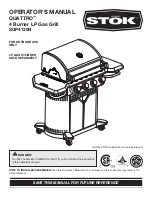
24
HELPFUL HINT
You can reduce the strength of the smoke flavor by only smoking for half or three quarters of the cooking time.
The heat required for smoking is normally low to medium.
KNOWING WHEN THE FOOD IS DONE
We strongly recommend using a meat thermometer. Food cooked on a grill can brown very fast on the outside,
well before it’s cooked on the inside. Many factors can influence cooking times, including wind, outdoor
temperatures, and altitude. Therefore, it’s best to use a meat thermometer to ensure your food has cooked long
enough. Check with your specific recipe, but for general guidelines:
1.
Hamburgers, sausages, and all ground meat should reach 160
°
F (71
°
C).
2.
Beef should reach 145
°
F (63
°
C) for medium rare
3.
Veal should reach 160
°
F (71
°
C) for medium and lamb should reach 145
°
F (63
°
C) for medium rare.
4.
Pork should reach 160
°
F (71
°
C).
5.
Poultry should reach 180
°
F(82
°
C), or 170
°
F(77
°
C) for boneless pieces.
GRILLING TIPS AND TRICKS
1.
Always “Preheat” your grill before cooking. Light all main burners, turn to “HI”, and close the lid until
the thermometer reads over 500
°
F (260
°
C), which should be 5 to 10 minutes. Then adjust the burner
control knobs to the proper temperature. Note that no preheating is necessary for the side burner.
2.
The thermometer measures the temperature at the top of the lid. The temperature down by the cooking
grates is generally somewhat warmer.
3.
Mother Nature can impact your grilling times. Allow more cooking time for cold, wind, and higher
altitudes. We recommend you place the grill in an area protected from much wind.
4.
Trim away any excess fat from meat to reduce flare-ups.
5.
Keep similar size portions together so that they cook more evenly.
6.
Generally speaking, the more food on the grill, the longer the cooking time.
7.
Be aware when using the Direct cooking method, as food can easily become overcooked, burned, or dry
out. Food may require more turning, or sometimes, may need to be moved off the flame.
8.
Larger pieces of meat generally require more cooking time per pound than smaller pieces of meat.
9.
If a major flare-up, or too many flare-ups occur, turn off the gas, move the food away from the flare-up,
and close the hood. Restart the grill once the flare-up has died down.
10.
Turn foods infrequently. Generally, only turn a steak once during cooking.
11.
Use tongs rather than a fork when turning the food on the grill. Less juice will be lost that way.
12.
Know your sauce and when to apply. Oil and vinegar based sauces can be brushed on any time. Sugar
based sauces like barbecue sauce should be applied during the last few minutes of cooking.
13.
A timer can help you keep from over-cooking the food.
14.
Use insulated protective mitts or potholders when working around a grill in operation.
15.
Use a small amount of cooking oil on the cooking grates before heating to reduce foods sticking on the
grates.
FOOD SAFETY
1.
Always use safe food handling and preparation when using this grill.
2.
Wash all poultry, seafood, and vegetables before cooking.
3.
Use separate platters, plates, and utensils for uncooked and cooked foods.
4.
Leave all meat, poultry, and seafood in the refrigerator until ready to cook.
5.
Use a meat thermometer to ensure foods are adequately cooked.



































